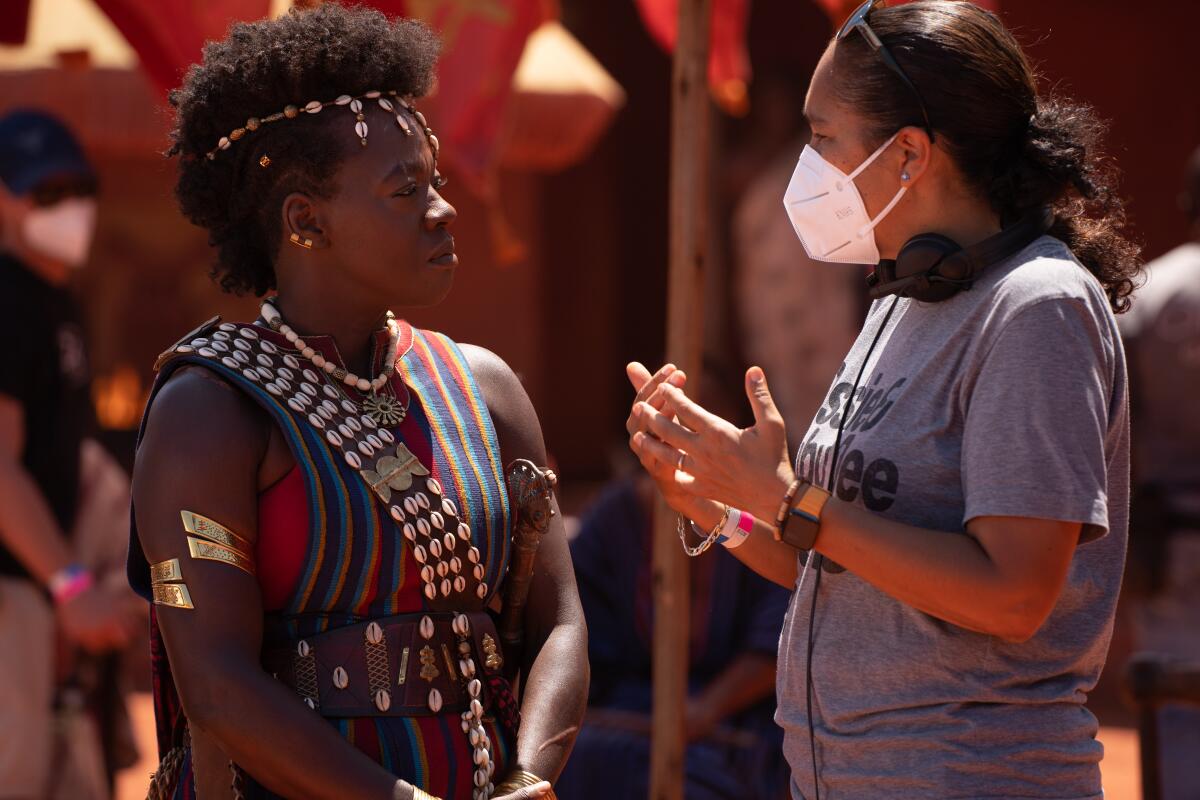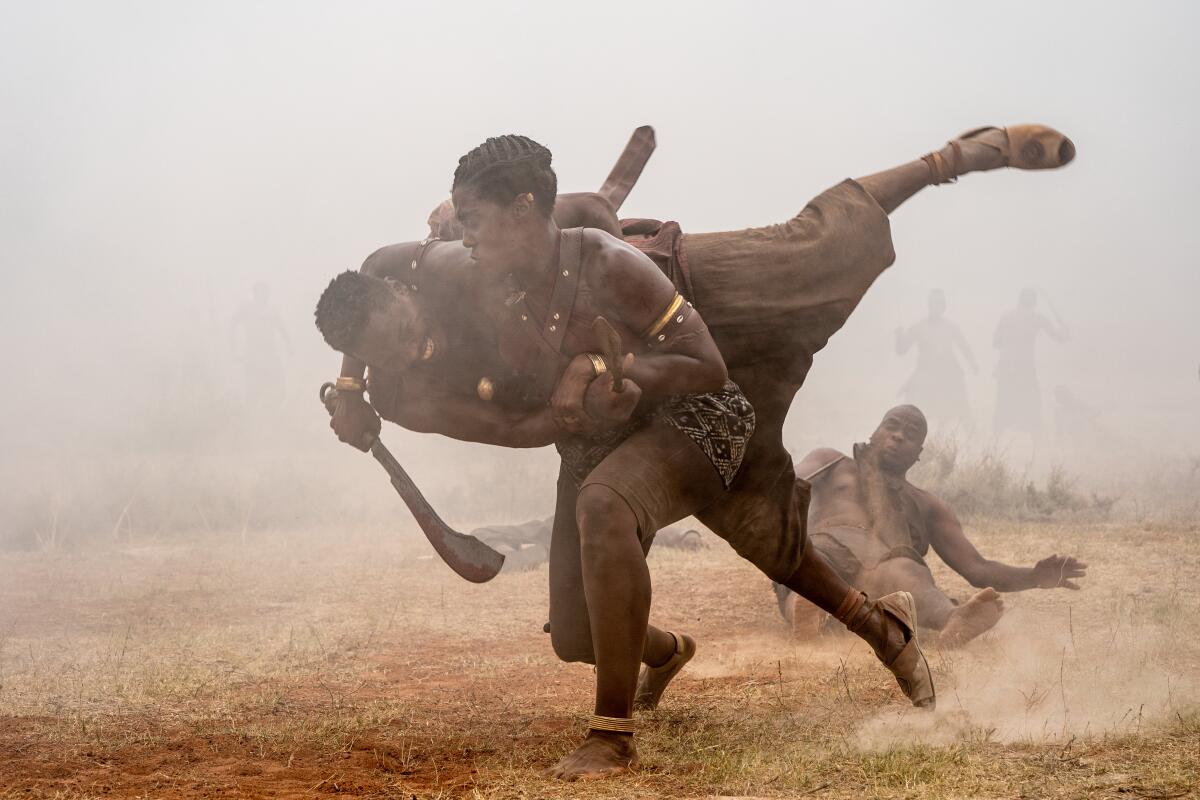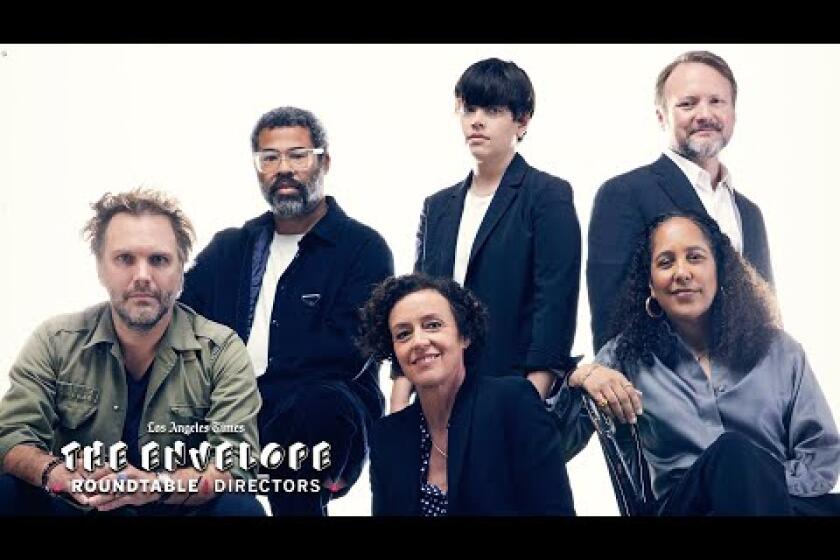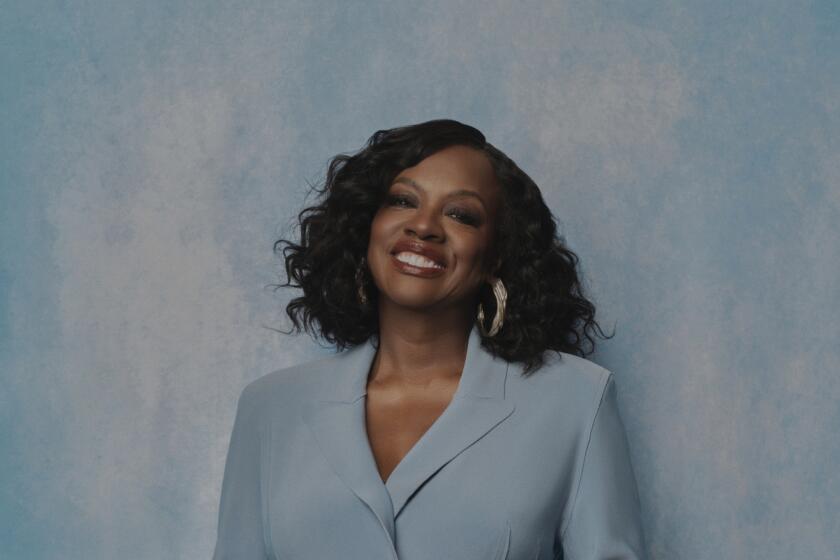How the ‘Woman King’ crew found a safe space to be heard

- Share via
“The Woman King,” a historical epic about a West African unit of warriors in 1823, may feel revolutionary to audiences today — but there are still wars being waged by women and people of color today on very different fields of battle.
Director Gina Prince-Bythewood made a specific effort to hire heads of department for the film that reflected the makeup of the people on camera, which led to a collection of women and artisans of color so remarkable that cinematographer Polly Morgan recalls taking a photo of all the directors chairs for crew set up behind the camera. “There were no male [assigned] chairs,” she marvels.
The Envelope held a Zoom chat with several members of the remarkable crew: Morgan, Prince-Bythewood, editor Terilyn A. Shropshire, costume designer Gersha Phillips and VFX supervisor Sara Bennett to explore just how big a difference it makes when women are put in charge.
Gina, obviously, you’re hiring the most talented people for the jobs behind the camera. But how important were the demographics of the most qualified individuals?
Gina Prince-Bythewood: It’s a hard thing to answer, because it’s not a PC thing. For me, it is the knowledge of how many talented women and people of color out there who haven’t gotten the opportunity. Not everybody takes the time to look beyond the resume. I was actively looking for those women to help me tell the story.
The directors at this year’s Envelope Roundtable -- Rian Johnson, Jordan Peele, Gina Prince-Bythewood, Maria Schrader, Charlotte Wells and Florian Zeller -- found shared experiences.
Does having so many women heading up departments change the energy on set?
Prince-Bythewood: When suddenly we are the majority, it opens us up in a way that we don’t often get to do. We know for sure our voice matters; our voice is going to be heard.
Polly Morgan: I think women are more open to share ideas in an open platform. There’s all different types of men and all different types of women out there — but in a very generalized way, we’re able to share ideas and bounce back and forth in a non-egotistical way.
Prince-Bythewood: Every one of us on this call at some point on sets has dealt with someone who was a chauvinist or misogynist. The energy of dealing with that, coupled with the amount of energy we need for creativity — it takes up space. In a space where you’re not dealing with that at all, it opens you so that you get to 100% focus on creativity.
Sara Bennett: I find it easier to talk and come up with ideas and bounce things off [everyone else].
Were there circumstances where you wanted to hire a woman or person of color to be a department head but couldn’t find enough people who run those areas?
Prince-Bythewood: When I come in as a director and talk with my producers, the first thing I talk about is that my crew is going to reflect the faces in front of the camera. I’ve been told on every single movie, “I’m sorry, there aren’t enough qualified people,” and it’s bull—. Take the time and you reach out to people and you get incredible artists. They are out there.
Terilyn A. Shropshire: I’m on this panel today because of directors like Gina, or Kasi Lemmons, people who gave me the opportunity to walk in the door and interview. When you walk through the threshold of an interview, you have to show the person who you are. But if you can’t even get the interview, if you can’t get past whatever the firewall is, then it’s very difficult.

“Male gaze” in movies is attributed to something that objectifies women on camera by making everything about the male point of view — like a shot where a woman exits a car and a camera pans from the ground all the way up her legs. Are you able to counter that more effectively with more women in more department head positions?
Phillips: Definitely. Women have been objectified with costumes so often. When I did the women and the men [in a Mirror Universe arc of “Star Trek: Discovery”], I did them the same. We wanted our uniform to be nonbinary, to show that men and women could be powerful. That said, all I’ve ever thought about with women showing legs when they get out of cars is it allows us to see the shoes that we’ve designed or put together with that costume.
Shropshire: For me, it’s about the material that comes in and the decisions made on set. Within the fight scenes in “Woman King” … there were moments when I wanted to hold on to a look. To hold on to a certain type of movement because of the beauty of the bodies of the female warriors. I felt Gina’s gaze, so to speak, was to show the humanity but also show the character of these women. To make sure they were all featured as part of the scope of the fight.

Prince-Bythewood: Women directing action is sadly still rare. But think about how many times you’ve seen two women fight in an action film and how often, look, the tank top got ripped. And the fights become sexualized or they become cat fights. For us, it’s about celebrating the athletic form of a woman. What we choose to put in our frame is different because of our mentality.
The actor and her husband laugh together and work together. And together, they pushed through the historical action epic “The Woman King.”
How would you say that the setup behind the scenes on “Woman King” may have changed you or how you see your jobs?
Bennett: I was lucky on [Prince-Bythewood’s] “The Old Guard” and “Woman King” that we had a lot of female heads, and a lot of female presence within the film. Going forward, I’d be much more aware of who was on the crew because it’s such a nice atmosphere, and it’s much more collaborative. It’s not just middle-age white men sitting around the table.
Phillips: Coming through this journey has made me stronger. I’m better able to assess issues and problems faster.
Are things inching forward for women and people of color in terms of more freedom and less questioning? Or is that just wishful thinking?
Prince-Bythewood: There are more of us getting the opportunity, and the more of us in the director’s chair, the more that this type of group is going to come together. That means more people are going to have this on their resume, and that means less questioning. The hope is that it inspires people to look beyond the resume and give people an opportunity. Everybody on this film made me better.
More to Read
From the Oscars to the Emmys.
Get the Envelope newsletter for exclusive awards season coverage, behind-the-scenes stories from the Envelope podcast and columnist Glenn Whipp’s must-read analysis.
You may occasionally receive promotional content from the Los Angeles Times.









